Creating the Perfect Alpine Garden: Essential Tips for Success
Creating a thriving alpine garden requires attention to several key elements. Start by selecting a site with excellent drainage—alpine plants hate wet feet and will quickly rot in soggy conditions. Incorporate plenty of grit, sand, or small gravel into your soil mix to improve drainage and mimic the mountainous conditions these plants naturally thrive in. Position your garden in a location that receives at least 6 hours of sunlight daily, though some afternoon shade can be beneficial in hotter climates. When arranging your rocks, place the largest ones first and partially bury them to create a natural look while establishing the garden’s structure. Space your plants appropriately, considering their mature size to prevent overcrowding. Water new plantings regularly until established, then reduce frequency as alpine plants prefer drier conditions once their root systems develop. Apply a thin layer of gravel mulch around plants to suppress weeds, retain moisture, and provide a clean backdrop that showcases your alpine treasures. Remember to remove spent flowers to encourage reblooming and maintain your garden’s tidy appearance throughout the growing season.
10 Stunning Alpine Plant Varieties to Showcase in Your Garden
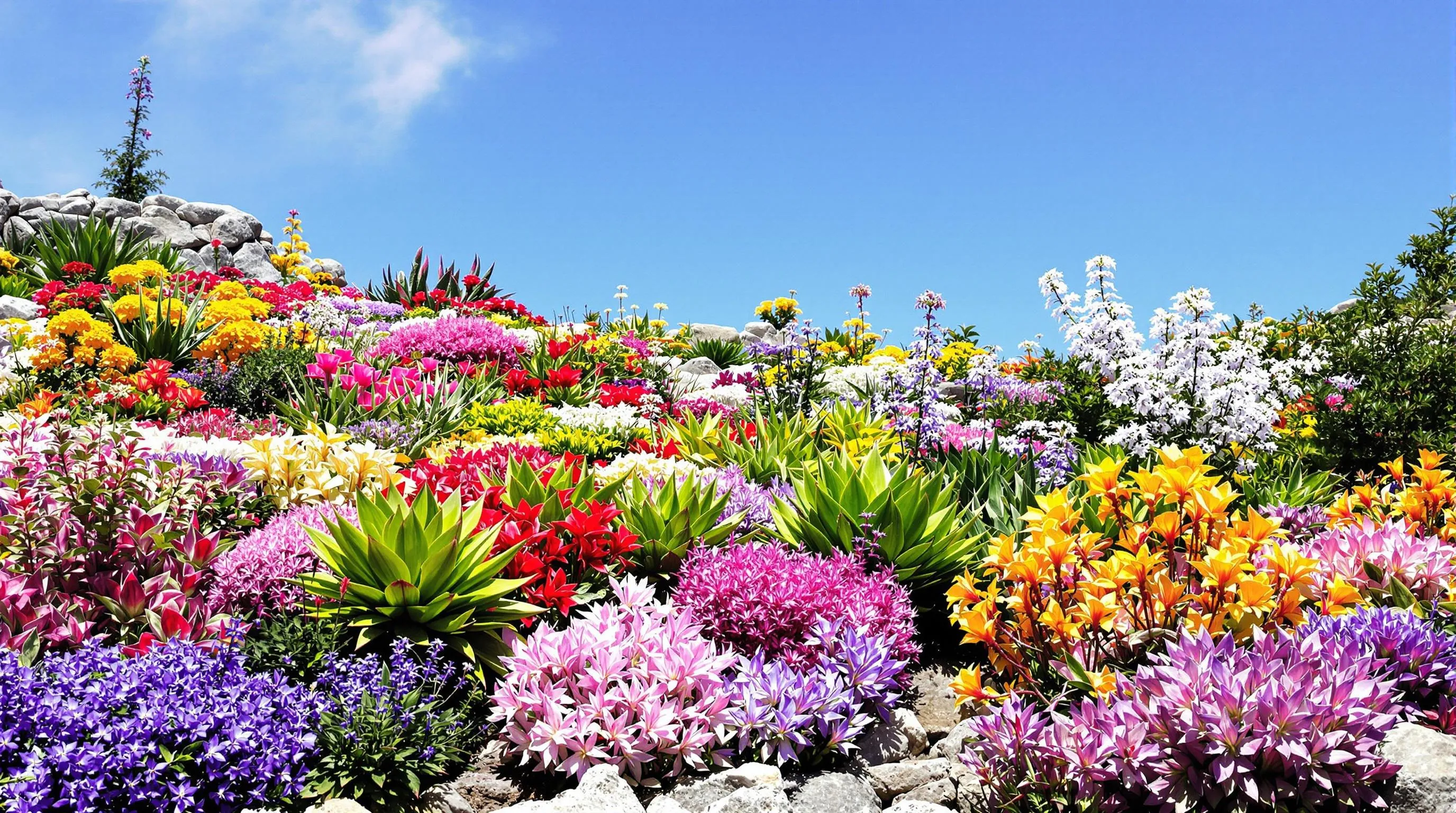
Alpine gardens come alive with the right plant selection. These hardy mountain natives bring texture, color, and resilience to your rock garden while maintaining that authentic alpine aesthetic.
Low-Growing Alpine Gems
- Saxifraga – These cushion-forming plants create dense mats of foliage with star-shaped flowers in white, pink, or red. Saxifraga ‘Silver Cushion’ offers silvery rosettes that look stunning against dark rocks.
- Sempervivum (Hens and Chicks) – Perfect for tucking into rock crevices, these rosette-forming succulents come in countless varieties with colors ranging from green to burgundy. They multiply readily, creating natural-looking colonies.
- Sedum (Stonecrop) – These drought-tolerant succulents form attractive ground covers with fleshy leaves and star-shaped flowers. Sedum spathulifolium ‘Cape Blanco’ features powdery silver-white rosettes with yellow summer blooms.
- Thymus serpyllum (Creeping Thyme) – This aromatic ground cover creates a carpet of tiny leaves that release their scent when stepped on. In summer, it’s covered with purple-pink flowers that attract pollinators.
- Armeria maritima (Sea Thrift) – Forming neat, grassy mounds, sea thrift produces globe-shaped pink or white flowers on slender stems from spring through summer. It’s particularly salt-tolerant for coastal alpine gardens.
Colorful Alpine Bloomers
- Gentiana acaulis (Trumpet Gentian) – Famous for its electric blue, upward-facing trumpet flowers, this low-growing perennial creates a spectacular spring display. It prefers acidic soil conditions and partial shade.
- Lewisia cotyledon – These rosette-forming perennials produce multiple flower stalks bearing vibrant blooms in shades of pink, orange, and white. They need excellent drainage and protection from winter wet.
- Dianthus alpinus (Alpine Pink) – With their blue-green foliage and fragrant, fringed flowers in shades of pink and white, alpine pinks add charm to any rock garden. They bloom profusely in early summer.
- Phlox subulata (Moss Phlox) – Creating a dense carpet of needle-like foliage, moss phlox erupts with flowers in spring. Varieties like ‘Emerald Cushion Blue’ and ‘Candy Stripe’ offer stunning color options.
- Aquilegia alpina (Alpine Columbine) – Taller than many alpines at 12-18 inches, this delicate beauty features nodding blue flowers with distinctive spurs. It self-seeds gently to create naturalistic drifts.
Designing with Rocks: How to Create Authentic Alpine Terrain
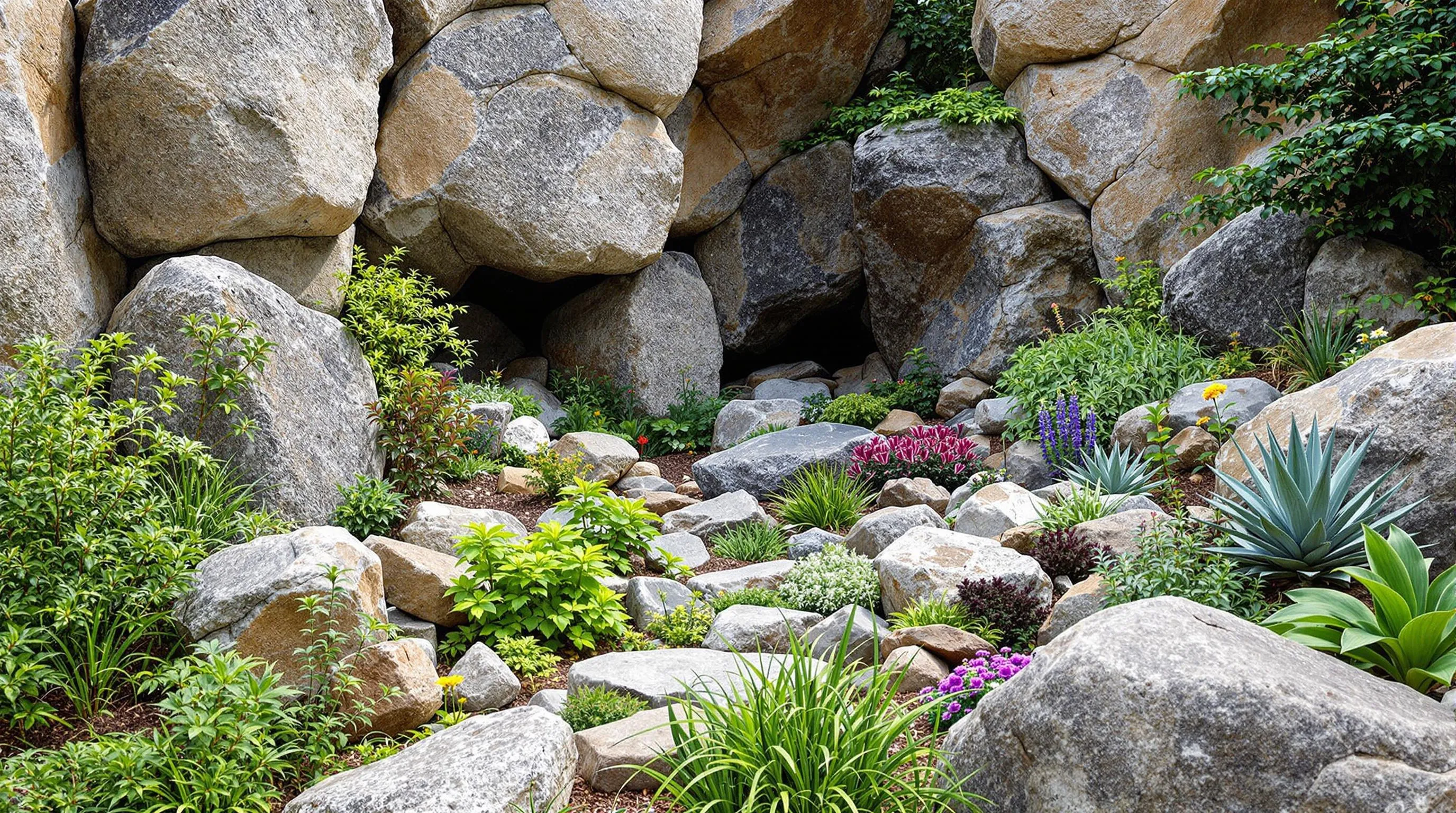
The foundation of any successful alpine garden lies in how convincingly you recreate mountain terrain through thoughtful rock selection and placement. Creating authentic alpine terrain requires both artistic vision and practical knowledge of how mountain landscapes naturally form.
Choosing the Right Rocks
The right rocks form the backbone of your alpine garden’s authenticity. Select local stones whenever possible, as they’ll create the most natural-looking environment for your region. Limestone works exceptionally well for alpine gardens because it mimics the alkaline conditions many mountain plants prefer, while sandstone offers excellent drainage properties. Avoid using more than 2-3 rock types to maintain visual cohesion—mixing granite with slate and limestone often creates a jarring, artificial appearance. Size variation is crucial; include several larger “anchor” rocks (24-36 inches across) alongside medium specimens (12-18 inches) and smaller accent pieces. Weather-worn rocks with interesting textures, crevices, and natural coloration will instantly elevate your garden’s authenticity compared to freshly quarried specimens that look artificially placed.
Strategic Rock Placement Techniques
Position your largest rocks first, burying approximately one-third of their mass to create the illusion they’re naturally emerging from the earth rather than simply sitting on top. Arrange rocks in asymmetrical groupings of odd numbers (3, 5, 7) to mimic nature’s random patterns—perfectly spaced rocks immediately signal human intervention. Create realistic strata by aligning sedimentary rocks horizontally as they would appear in nature, with their layers running in the same direction. Develop “crevice gardens” by setting flat rocks vertically with narrow gaps between them where alpines can root deeply while their foliage spills over the rock face. Leave adequate planting pockets between rocks—spaces roughly 8-12 inches wide allow sufficient room for plant development while maintaining the close-growing character of alpine communities. Always consider water flow when placing rocks, creating natural channels that direct moisture to plants while allowing excess to drain away quickly.
Alpine Garden Containers and Troughs for Limited Spaces
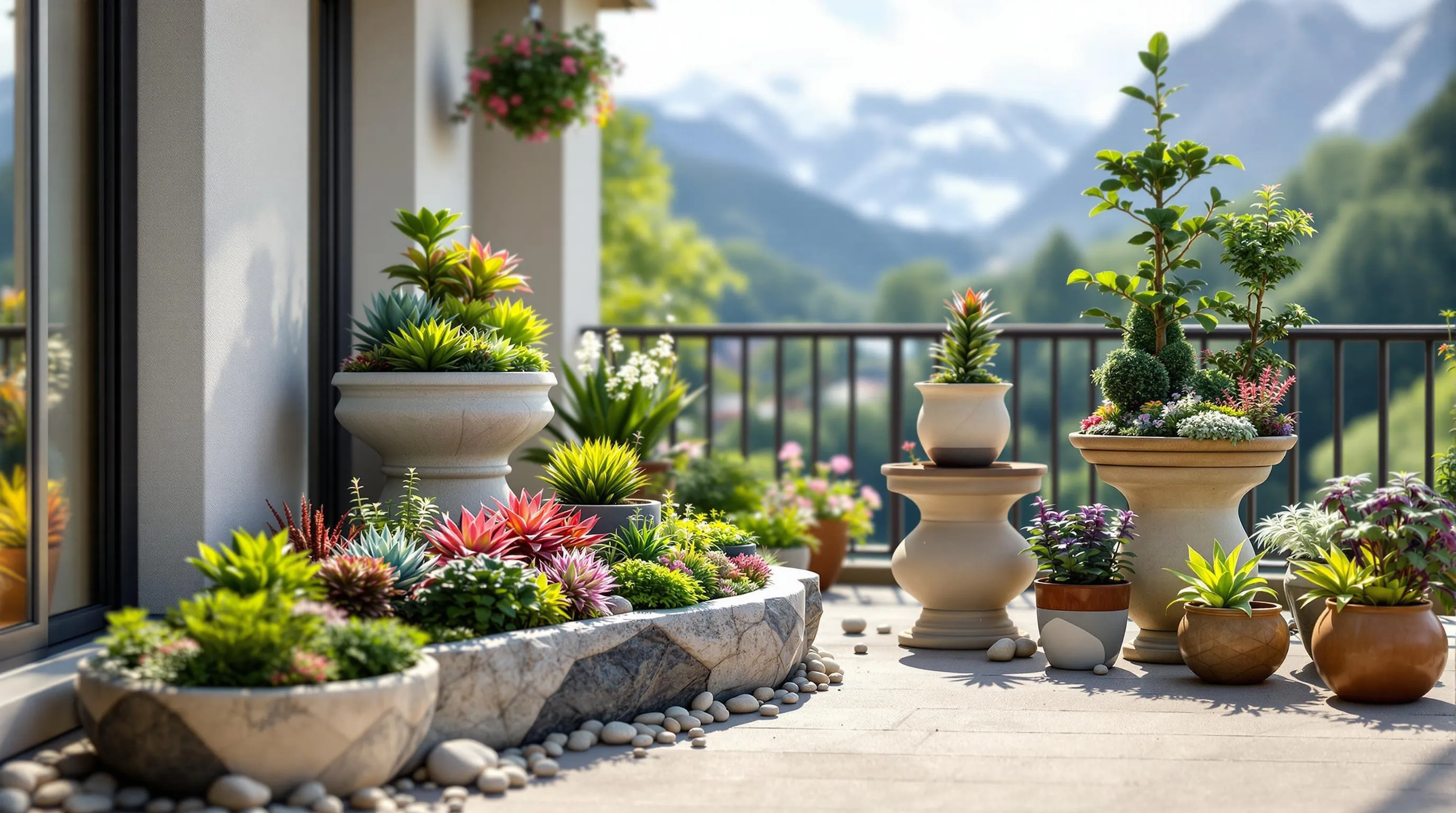
You don’t need a sprawling yard to enjoy the beauty of alpine plants. Container gardening offers a perfect solution for creating miniature mountain landscapes on patios, balconies, or even windowsills. These portable gardens allow you to cultivate alpine treasures in spaces where traditional rock gardens aren’t possible.
Stone troughs, hypertufa containers, ceramic pots, and repurposed items can all become homes for your alpine collection. The key is selecting containers with excellent drainage and enough depth for root development. When filled with the right soil mix and thoughtfully arranged plants and rocks, these small-scale gardens capture the essence of alpine environments in a compact form.
Position your container alpine gardens where they’ll receive adequate sunlight (typically 6+ hours daily) while protecting sensitive species from intense afternoon heat. Elevated locations like tables or pedestals make these miniature landscapes easier to appreciate and maintain. Group multiple containers of varying heights to create a ever-changing display that mimics the undulating terrain of mountain slopes.
For apartment dwellers or those with limited outdoor space, alpine troughs bring the mountain garden experience to your doorstep. Their versatility allows you to experiment with different plant combinations and microenvironments without committing to a permanent garden installation.
Alpine Water Features: Incorporating Streams and Miniature Pools
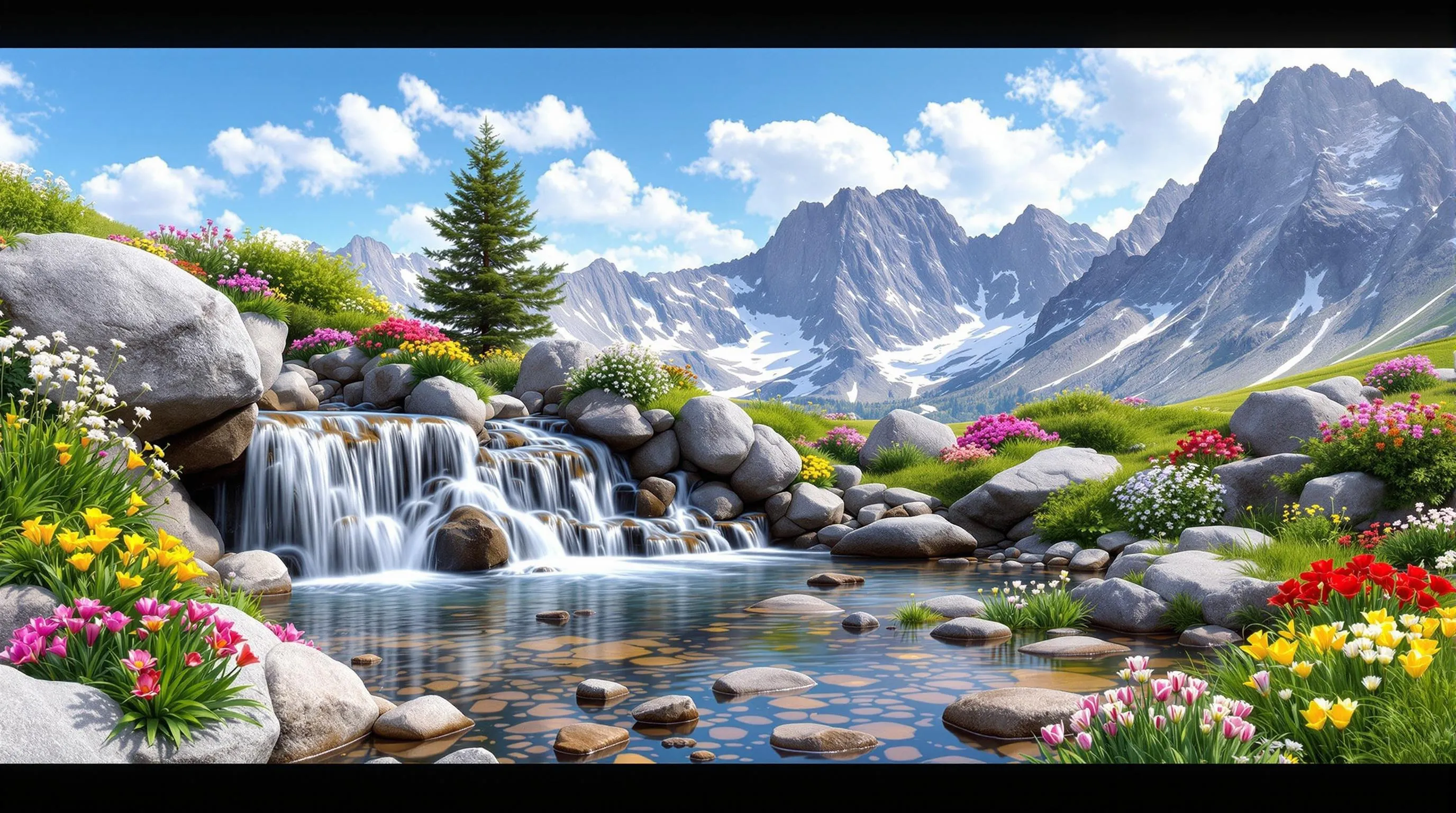
Water features add movement, sound, and life to alpine gardens, creating a more authentic mountain industry experience. The gentle trickle of water over rocks mimics high-altitude streams while providing habitat for specialized plants.
Low-Maintenance Water Elements
Creating low-maintenance water features for your alpine garden doesn’t require elaborate setups or constant attention. Small recirculating pumps hidden among strategically placed rocks can create charming miniature waterfalls that use minimal water. Consider installing a shallow rock basin that captures rainfall naturally, forming temporary pools that alpine plants will appreciate. Solar-powered water features eliminate the need for electrical connections while keeping maintenance simple. Pebble fountains work beautifully in alpine settings—water bubbles up through smooth stones without creating large open water areas that might require frequent cleaning. For the simplest approach, position concave rocks to collect morning dew and rainfall, creating micro-habitats that certain alpine species will thrive alongside.
Plants for Alpine Water Margins
The transition zone between rock and water offers perfect growing conditions for specialized alpine plants. Primula auricula showcases rosettes of fleshy leaves and vibrant yellow blooms that thrive in damp crevices near water. Soldanella alpina, with its delicate fringed purple flowers, naturally grows where snowmelt creates temporary moisture. Incorporate Parnassia palustris (Grass of Parnassus) for its striking white flowers with distinctive green veining that appear in late summer. Dwarf rushes like Juncus effusus ‘Spiralis’ add architectural interest with their corkscrew stems while tolerating consistently damp conditions. For cascading beauty over rock edges near water, plant Saxifraga aizoides with its yellow star-shaped flowers and succulent foliage. These moisture-loving alpines create natural transitions between your rock formations and water elements, improving the authentic mountain stream aesthetic of your garden.
Seasonal Maintenance Tips for Thriving Alpine Gardens
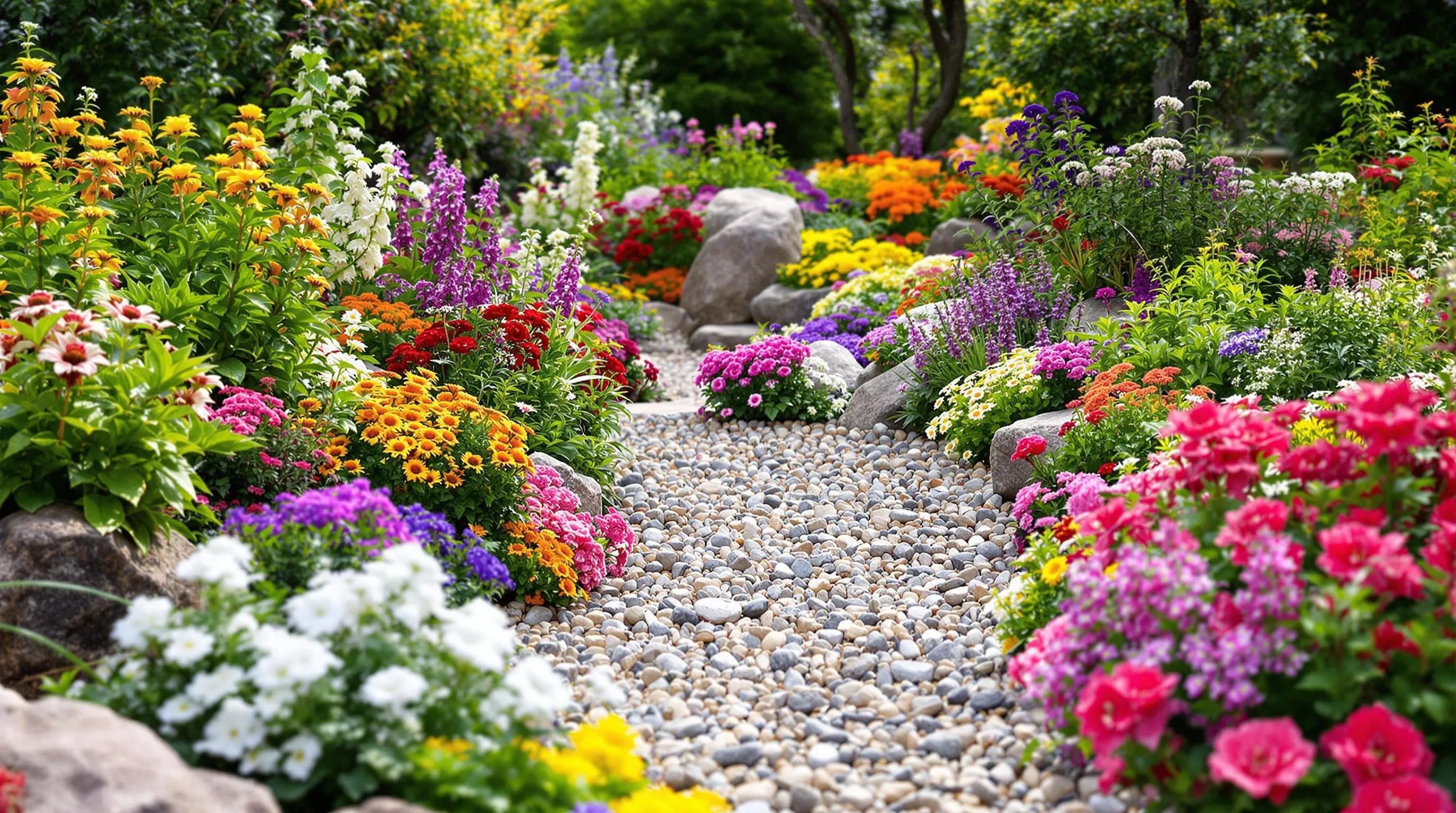
Alpine gardens require exact care throughout the year to maintain their beauty and ensure plant health. Following these seasonal maintenance practices will help your alpine garden thrive year-round.
Spring and Summer Care
Spring marks the beginning of active growth in your alpine garden, requiring exact attention to maximize plant health. Start by gently removing winter mulch in early spring once frost danger has passed to prevent crown rot in your alpine plants. Inspect for winter damage and prune dead or damaged foliage with sharp, clean scissors. Apply a thin layer of fine gravel or grit around plants to suppress weeds while maintaining the alpine aesthetic. Water newly emerging plants carefully using a gentle spray to avoid disturbing small specimens, typically in early morning when temperatures are cooler. During summer, monitor moisture levels closely, watering only when the top inch of soil feels dry, as most alpine plants prefer drier conditions. Remove spent flowers regularly to encourage reblooming and prevent self-seeding that could overwhelm your carefully planned design. Watch for pests like aphids and slugs, addressing them promptly with organic controls such as neem oil or diatomaceous earth to preserve the garden’s ecological balance.
Fall and Winter Protection
Preparing your alpine garden for colder months ensures plant survival and spring vigor. Begin fall maintenance by clearing fallen leaves from around alpine plants to prevent rot and fungal issues that thrive in damp conditions. Cut back any overgrown perennials after flowering has finished, but leave architectural seedheads for winter interest and bird food. Apply a thin layer of grit around plant crowns to improve drainage during wet winter months, preventing crown rot that commonly affects alpine specimens. For less hardy alpine varieties in colder regions, consider placing evergreen boughs or pine straw as light protection without trapping excessive moisture. Small alpines in troughs or containers should be moved to sheltered locations like unheated garages or against house foundations where they’ll receive some protection from harsh winds and temperature fluctuations. In regions with fluctuating freeze-thaw cycles, protect vulnerable rock garden plants with cloches or horticultural fleece during the most extreme weather while ensuring adequate ventilation on milder days. Remove snow carefully from delicate evergreen alpines to prevent branch breakage, but allow some snow cover on dormant plants as natural insulation against temperature extremes.
Creative Alpine Garden Themes to Try at Home
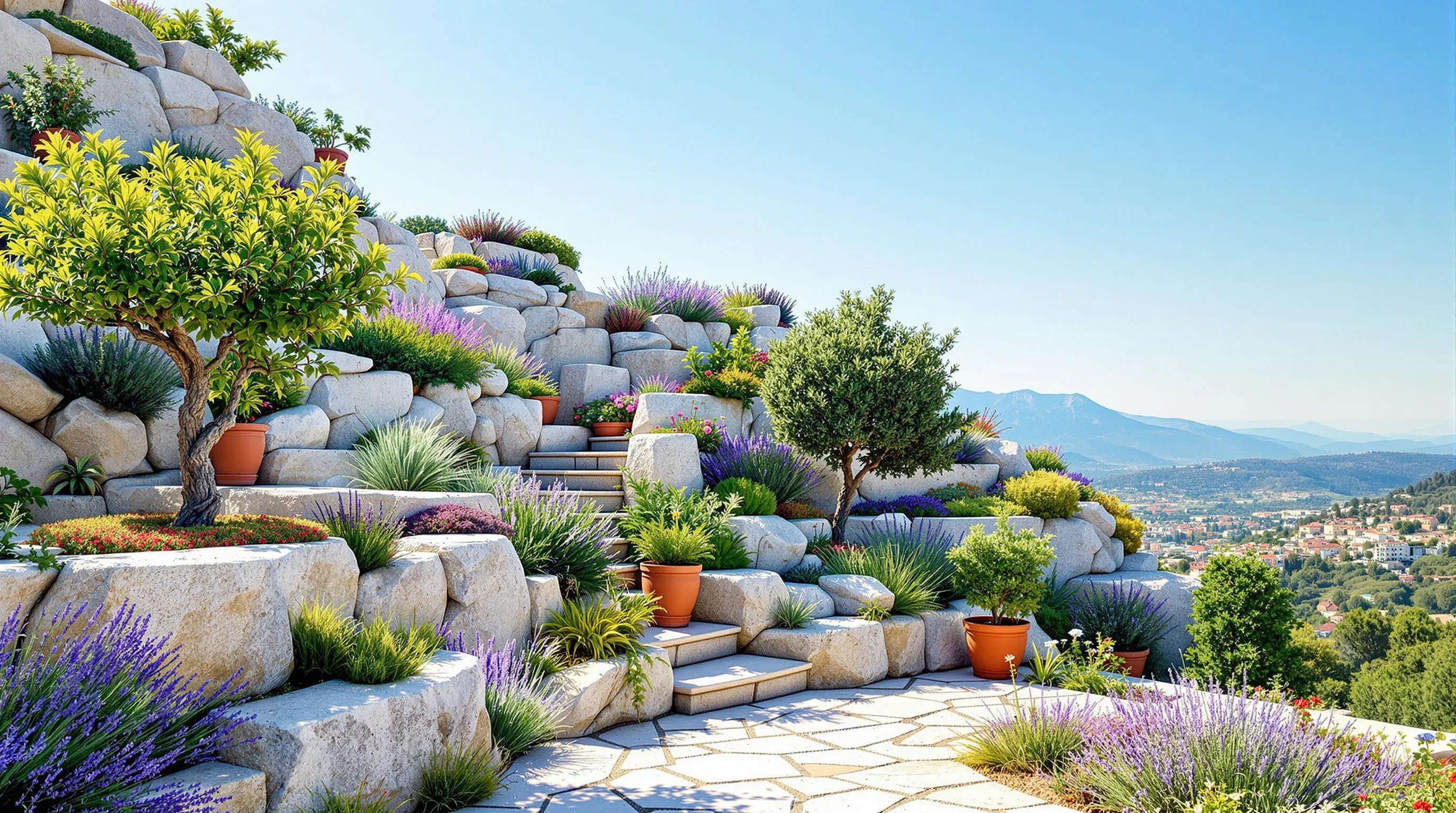
Themed alpine gardens allow you to express your creativity while maintaining the core principles of rock gardening. These specialized designs draw inspiration from different cultures and landscapes, adding personality to your outdoor space.
Mediterranean Alpine Style
Transform your alpine garden into a sun-drenched Mediterranean retreat by incorporating elements from Southern European mountain regions. Select drought-tolerant alpine plants like lavender, thyme, and artemisia that thrive in rocky, arid conditions. Arrange limestone rocks to create terraced levels reminiscent of Mediterranean hillsides. Add terracotta pots and ornaments to enhance the warm, rustic aesthetic. Plant silver-leaved specimens such as Artemisia schmidtiana ‘Silver Mound’ and blue-flowering plants like Edraianthus graminifolius to capture the distinctive Mediterranean color palette. Complete your garden with gravel mulch in warm tones and perhaps a small olive tree as a focal point to evoke the charm of alpine villages in Italy, Spain, or Greece.
Japanese-Inspired Alpine Gardens
Blend the serenity of Japanese garden principles with alpine elements to create a tranquil mountain retreat. Focus on careful rock placement that mimics natural formations, using vertical stones to represent mountains and horizontal ones for stability and balance. Choose alpine plants with a compact, restrained growth habit such as miniature conifers, small azaleas, and tufted grasses that complement the zen aesthetic. Incorporate moss between rocks to soften edges and create the appearance of age. Add traditional Japanese elements like a small stone lantern, a bamboo water spout, or a miniature bridge spanning a dry streambed lined with smooth pebbles. This fusion style emphasizes negative space and contemplative viewing points, allowing the eye to rest while appreciating the subtle beauty of carefully selected alpine specimens against thoughtfully arranged rocks.
Troubleshooting Common Alpine Garden Challenges
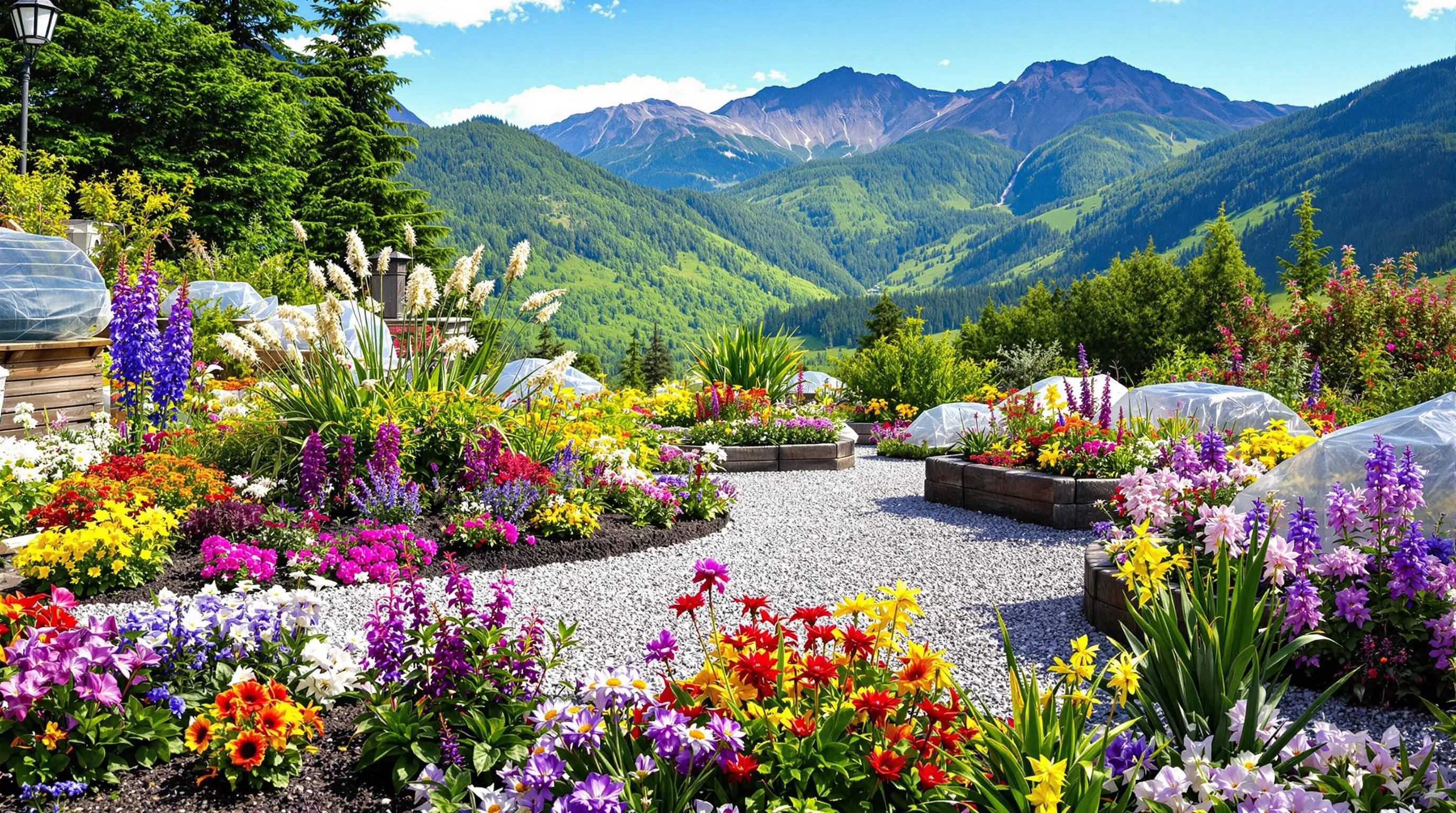
Even the most carefully planned alpine gardens can face obstacles that threaten their beauty and health. Poor drainage remains the number one killer of alpine plants, causing root rot and fungal diseases. To address this issue, add more gritty material to your soil mix or create raised beds with better drainage. Excessive moisture during winter months can be particularly dangerous, so consider installing clear covers that shield plants from rain while allowing airflow. Weeds frequently invade the spaces between your carefully placed specimens—tackle them early by hand-pulling before they establish deep roots, and maintain a fresh layer of gravel mulch to suppress their growth. If your alpine plants fail to bloom, they may need more sunlight or less competition from neighboring plants. Pests like slugs and snails can devastate tender growth—apply diatomaceous earth around vulnerable plants or use copper tape barriers around containers. For plants that appear stunted or yellowing, a light application of slow-release fertilizer formulated for alpine plants may restore vigor without promoting excessive, floppy growth that detracts from their compact charm.
Alpine Garden Accessories and Décor Elements

The right accessories and décor elements can transform your alpine garden from a simple rock arrangement into an enchanting mountain-inspired retreat. Miniature alpine houses add whimsical charm and create focal points among your rocky terrain. Consider placing small stone cottages, tiny wooden bridges, or diminutive mountain chalets strategically throughout your garden. Natural wood elements like driftwood pieces or weathered branches introduce organic texture that complements the rugged stone features. For authenticity, incorporate metal elements such as copper or wrought iron plant markers, which develop an attractive patina over time. Small stone lanterns or solar lights can illuminate pathways and highlight special plants after sunset. Alpine-themed statuary including mountain animals like ibex, marmots, or eagles adds personality, while strategically placed mirrors can create the illusion of expanded space in smaller gardens. Glass elements such as colored orbs or pebbles catch and reflect light, bringing sparkle to shady corners. Finally, consider adding bench seating from natural materials to create peaceful viewing spots where you can appreciate your miniature mountain industry from different perspectives.
Sustainable Practices for Alpine Garden Enthusiasts
Your alpine garden adventure awaits with endless possibilities for creativity and natural beauty. Whether you choose a sprawling rockery filled with colorful blooms or a simple container arrangement on your balcony these miniature mountain landscapes bring unique charm to any space.
Remember that successful alpine gardens balance authentic design with proper plant selection and thoughtful maintenance. The reward is a resilient display that evolves with the seasons offering year-round interest with minimal upkeep.
By implementing the techniques shared here you’ll create not just a garden but a peaceful retreat that captures the spirit of mountain landscapes. Start small experiment with different plants and rocks and watch your alpine oasis flourish into a stunning focal point in your outdoor space.





